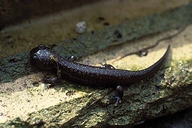|
Description
Hynobius kimurae has a snout to vent length of 57-97 mm and a total length of 101-184 mm. It has a long and robust trunk, a thick tail, and 13, or sometimes 14, costal grooves. Its limbs and toes are short and when its limbs are adpressed to the flank, there is a gap of 0.5-3.5 costal grooves between the fore and hind toes. Its hind feet have 5 toes. The ground color of H. kimurae is purplish black and is speckled with erratic gold blotches. The blotches may be tiny dots or more like freckles and they may be dense or sparse, depending on the region of the individual, but they are about the same size all over the dorsal surface. The ventral surface is lighter with almost no blotches.Hynobius naevius is easily confused with H. kimurae, but its blotches are silver to white and vary in size on the same individual. The tail of H. naevius is also higher and more vertically compressed than that of H. kimurae. Distribution and Habitat
Country distribution from AmphibiaWeb's database: Japan
H. kimurae is found in the mountainous regions of central to southwest Honshu, living in both deciduous and coniferous forests on the slopes of hills and mountains, often above 1000 m. It disperses on the slopes and lives in moist places under old logs, large rocks, forest litter in seepage areas, etc.Life History, Abundance, Activity, and Special Behaviors
H. kimurae emerges at night or on rainy days to forage for earthworms, slugs, spiders, small insects, etc. Before the first snowfalls cover the ground, it migrates to the headwaters of the breeding streams, where it spends the winter under logs and rocks in the shallows. It lays its egg sacs under rocks in the headwaters or side rivulets of mountain brooks, typically in eddies where the current is not too strong. The breeding season lasts from the beginning of February to the beginning of April. There is little information on breeding activity. The pair of egg sacs is long and straight. The tip of the sacs not attached to the rock is bent back sharply in a hook and generally contains no eggs. The gelatinous sac has a purplish luster and is very tough. A total clutch consists of 13-51 eggs. After hatching, the larvae may remain for days or weeks inside the sac and emerge at the end of May to the middle of June. The larvae live along the edges of the stream where the current is slowest, feeding on mayfly larvae and other aquatic life forms, including smaller larvae of H. naevius. Many of the larvae have claws, which disappear at metamorphosis. Metamorphosis and emergence take place from the end of August to September or in spring and summer of the following year. The year of metamorphosis seems to be determined by the food supply and whether or not the stream dries up in fall. Comments
"Hida" is a locality in central Honshu from which this species was first reported.
References
Goris, R.C. and Maeda, N. (2004). Guide to the Amphibians and Reptiles of Japan. Krieger Publishing Company, Malabar, Florida.
Originally submitted by: Nichole Winters (first posted 2006-11-16)
Edited by: Tate Tunstall (2007-01-16)Species Account Citation: AmphibiaWeb 2007 Hynobius kimurae: Hida Salamander <https://amphibiaweb.org/species/3885> University of California, Berkeley, CA, USA. Accessed Nov 25, 2024.
Feedback or comments about this page.
Citation: AmphibiaWeb. 2024. <https://amphibiaweb.org> University of California, Berkeley, CA, USA. Accessed 25 Nov 2024.
AmphibiaWeb's policy on data use.
|





 Raffaëlli Account
Raffaëlli Account Map of Life
Map of Life